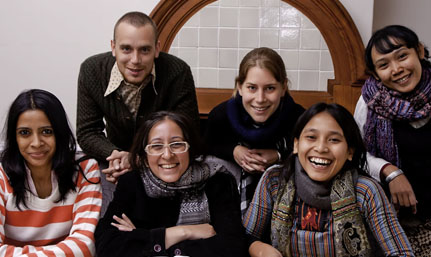|

|
Here are, from the left, front: Vinita Verma (India), Gayatai Sharma (India), Ambar Istiyani (Indonesia); back: Frank Nieuwenhuizen (Netherland); Vicky Hölsgens (Netherland) and Dewi Cahya Ambarwati (Indonesia)
Photo: Hannes Pieterse |
A group of activists, postgraduate students and staff from civil society organisations are currently visiting our Bloemfontein Campus to discuss issues of diversity and development. The group of 19 people from countries such as India, Indonesia, Uganda, the Netherlands and South Africa are part of the 2011 annual international winter school on Pluralism and Development, which is hosted by our International Institute for Studies in Race, Reconciliation and Social Justice. It is the first time that the winter school is held in South Africa since its launch in 2004.
The first class of the winter school started on 11 July 2011 and participants attend daily lectures where they engage in critical thinking about issues such as sustainable development, identity, reconciliation and pluralism. On Thursday 21 July 2011 our Vice-Chancellor and Rector, Prof Jonathan Jansen presented a lecture on reconciliation to participants where he spoke lengthily about South Africa’s traumatic past. Classes will come to an end on 5 August 2011.
During their stay at our university participants also visited Gauteng where they spent time at the Apartheid museum, Constitutional Hill and Freedom Park. Later this week they will visit our Qwaqwa Campus.
Indonesian participant, Ms. Dewi Cahya Ambarwati, said she is looking forward to the Qwaqwa visit, where she will show off her traditional dance. Ambarwati said during their visit to Freedom Park, she managed to trace back Indonesian ancestors in the museum’s slavery section. Another participant, Mr. Frank Nieuwenhuizen from the Netherlands, said the winter school is enriching because it makes you realise what it means to deal with differences.
The international Winter School on Pluralism and Development is an initiative of the Kosmopolis Institute of the University of Humanistic Studies, in cooperation with the Humanist Institute for Cooperation with Developing Countries (Hivos).